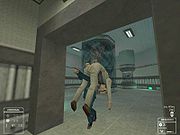
Science and Industry
Encyclopedia

Mod (computer gaming)
Mod or modification is a term generally applied to personal computer games , especially first-person shooters, role-playing games and real-time strategy games. Mods are made by the general public or a developer, and can be entirely new games in themselves, but mods are not standalone software and...
for the video game Half-Life. It is one of the oldest Half-Life mods and has been described as a classic one. The current version of the game is 1.1, released on December 14, 2006. The game was first publicly released on July 31, 1999, as version 0.94.
Gameplay
Players assume the role of a security guardSecurity guard
A security guard is a person who is paid to protect property, assets, or people. Security guards are usually privately and formally employed personnel...
for one of two fictional corporations Amalgamated Fluorodynamics (AFD) and Midland Carbide Labs (MCL).
The main objective on the standard map type is to capture enemy scientists (who are non-player character
Non-player character
A non-player character , sometimes known as a non-person character or non-playable character, in a game is any fictional character not controlled by a player. In electronic games, this usually means a character controlled by the computer through artificial intelligence...
s) while defending your own. This is accomplished by locating your enemies research labs, hitting one of the scientists there over the head with your briefcase and then taking him back to your company's administrator.
Additional scientists increase the rate of a company's income which can be considered the team's score.
Scientists also research new weapons, implants, armor upgrades and devices for their company. Each time a new technology is completed, players vote for the next one to be researched.
Players spawn in the "Cloning Facilities" of their company, where they can find weapons and ammo crates, as well as health and armor chargers. At the start of the game, the only weapons available are a briefcase and a pistol, but this arsenal grows bigger as new weapons are researched by the scientists. Players decide which technology to research next by voting for it. The available technologies are divided in 5 branches: Weapons, Armor, Implants, Devices and Process Upgrades.
Players decide to either defend their company or attack the other company. Attacking consists mainly of reaching the other company's laboratories, grabbing a scientist by knocking him out with the briefcase, and carrying back to the administrator. If a player dies while carrying a scientist, the scientist stays on the ground unconscious for a limited amount of time before teleporting back to his laboratories. During that time the original carrier or one of his teammates can pick up the scientist again. Some maps feature alternative objectives such as stealing resources (discs, biospecimen) or breaking computers. Defending requires protecting the company's laboratories, this is usually done by defending key areas (entries to the laboratories), killing intruders, and defending unconscious scientists.
Objectives
A standard game lasts 30 minutes. The company with the most money at the end wins.The main way to earn money is to have more scientists than the enemy. Each company starts with 3 scientists, so a company is making more money than the enemy corporation if it employs at least 4 scientists.
Some maps feature other objectives than capturing and protecting scientists. A first kind of alternative objective is breakables: these are computers or machinery that can be broken and cost money to replace. A second kind of alternative objective is resources: these are computer discs or research specimen that can be stolen and give a cash bonus.
Players also cost money to their company each time they die, since cloning them back to life is not free.

